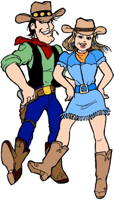
|
The Society of Folk Dance Historians (SFDH)
Country Western Tips and Suggestions
[
Home |
About |
Encyclopedia | CLICK AM IMAGE TO ENLARGE |

|
LEARNING TO DANCE
 If you're just starting out, keep in mind that becoming an accomplished dancer has nothing to do with any sort of previous experience or relative coordination, et cetera. Everyone has "two left feet" at first, including those you see gliding around the dance floor like pros. Your success, just like theirs, is governed only by your effort and personal determination. So, relax and enjoy yourself – you're going to have lots of fun and become a good dancer!
If you're just starting out, keep in mind that becoming an accomplished dancer has nothing to do with any sort of previous experience or relative coordination, et cetera. Everyone has "two left feet" at first, including those you see gliding around the dance floor like pros. Your success, just like theirs, is governed only by your effort and personal determination. So, relax and enjoy yourself – you're going to have lots of fun and become a good dancer!
GO SLOW AND ENJOY IT
It takes some time to learn this dancing and you'll need to be patient with your progress. The end result is a recreational skill and activity with long lasting depth and substance. With patience, time and practice, anyone can become an accomplished dancer!
USE WHAT YOU'VE LEARNED
Remember – the class simply "presents" you with the basic information you need. Actually, dancing it, just for fun, is where you become skilled and accomplished. A good "rule of thumb" is to dance at least one night a week (two to three hours). The more time you spend dancing outside of class, the faster you'll progress. You learn what to do in the classes, but you will only become skilled by using what you've learned.
MULTIPLE PARTNERS
This means dance partners. Everyone dances a little differently. Cultivating a large diverse group of dance partners is the fastest way to dramatically enhance your skill, and make new friends at the same time. Because Western Dancing is dependent on generous amounts of good will and patience, the folks who love Western Dancing tend to be fairly friendly, patient people. Active dancers will help you – just as others helped them when they started dancing – and as you'll help future beginners . . . that's how it works. Start by asking those you see dancing with many different people. You'll rarely be turned down, but when you are, don't take it too personally (they may just be tired) – ask someone else.
SAFETY AND COURTESY
The risk of physical injury, inherent in all Western Dancing, can be reduced by wearing appropriate foot wear, watching where you're going, and understanding the floor rules.
TWO-STEP FLOOR RULES
- Step off the floor when not dancing.
- When entering the floor, watch for an opening before merging with the flow.
- Dancers in front of you ALWAYS have the right-of-way, even if they're in the wrong dance lane.
- The OUTSIDE lane is for FAST-speed dancing only.
- The MIDDLE lane is for MEDIUM-speed dancing only.
- The INSIDE lane is for SLOW-speed dancing only.
- The CENTER is for Swing, Line, and other non-traveling (spot) dancing.
- Thou shalt not push, shove, or verbally assault another dancer or engage in other form of intentional harassment.
LINE DANCE FLOOR RULES
- Form lines from the CENTER of the floor.
- Maintain even spacing as the lines travel; look up!
NOTE: You don't have to be "perfect." If you don't remember the whole dance, GET OUT THERE ANYWAY! Dance on the ends of the lines. Follow as best you can and you'll begin remembering the steps.
Information provided by the Timberline, Seattle, Washington.
Reprinted from the 1993 University of the Pacific (Stockton) Folk Dance Camp syllabus.
This page © 2018 by Ron Houston.
Please do not copy any part of this page without including this copyright notice.
Please do not copy small portions out of context.
Please do not copy large portions without permission from Ron Houston.